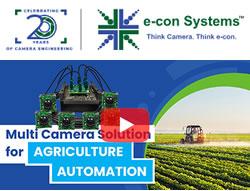Autonomous Technology Is the Key to Keeping up With Climate Change
.jpg)
Climate change is a serious issue affecting today’s farmers and ranchers. However, ongoing research suggests autonomous technologies could be instrumental in helping them monitor, respond to and reduce climate-related threats.
Increasing Infectious Disease Awareness
Research shows climate change has worsened the spread of infectious diseases in livestock and caused the reemergence of once-well-controlled health threats. One study showed another interesting aspect, suggesting that sicker livestock could exacerbate climate change. It showed that pathogen-induced emissions could cause up to 50% more methane in the atmosphere.
However, teams of agricultural scientists are interested in how autonomous technologies could help farmers and ranchers become aware of sick animals sooner. One example involves drones that can recognize unique cattle markings and track health statistics.
Another example comes from a team that developed automatic grazing sensors for lambs. Those devices could differentiate between inactive and active periods and show how frequently the animals ate. That data could aid in the early detection of illness, allowing people to quarantine sick animals sooner.
Helping Agricultural Professionals Adapt With Robots
Many farmers are now increasing their climate resilience by practicing regenerative agriculture. Options like no-till farming encourage soil health, while cover cropping fosters biodiversity. They may also need to adapt by becoming more dependent on robots.
For example, scientists have warned of the risk of certain products becoming less effective or ceasing to work because of climate change. Now is the time to begin exploring other possibilities, including those that involve autonomous technology.
One case involved using robots with ultraviolet lights to kill powdery and downy mildew on grapes. That pathogen is particularly tricky to handle because it can adapt to existing fungicides in only one season. One researcher who partnered on this project said some growers apply fungicide 10 to 15 times per year and that everyone who grows grapes must worry about the mildew.
However, tests showed using the robots to treat the grapes only once a week suppressed the mildew for two years. The machines also ran at night, so they didn’t interfere with farming activities during the day.
In another case, a research team built a robot that can sow, prune and harvest crops grown under solar panels. It supports an emerging technique called synecoculture that concerns growing various plants in high-density areas to promote biodiversity.
Specific design changes made the machine 50% better at obstacle avoidance than robots using simple controllers. The developers also made the robot support multiple tool attachments, increasing its usability.
Helping Farmers Get Ahead of the Weather
Scientists believe climate change is a factor in the severe and unseasonable storms affecting many parts of the world and making it more difficult for farmers to harvest their crops. However, autonomous farm equipment could remove that barrier.
Consider the case of a farmer who tried John Deere’s self-driving tractor. He enjoyed how it let him beat incoming storms by running 24 hours a day.
Users of the self-driving tractor can also access a dashboard showing the amount of running time versus idleness and the remaining fuel in the tank. Those statistics can assure farmers they’re being as sustainable as possible by not wasting resources.
Additionally, rain can make grass and weeds grow faster, making many people need to work harder to keep their lawns maintained during wetter conditions. When overseeing the fields that drive their profits becomes more challenging, lawn maintenance can quickly get overlooked due to time shortages and low energy. Autonomous mowing robots make the job manageable, with some covering up to 2.2 acres each hour.
Severe weather has always been a concern for farmers. However, as it happens more frequently and in unusual patterns due to climate change, autonomous technologies can help these professionals cope.
Autonomous Technology: Vital for Climate Change Preparedness
It’s impossible to know which areas, farms or crops will be most affected by climate change. However, many agricultural professionals are already dealing with the effects. These examples show why they should be open to using autonomous technologies to support their workflows now and into the future.
Comments (0)
This post does not have any comments. Be the first to leave a comment below.
Featured Product

